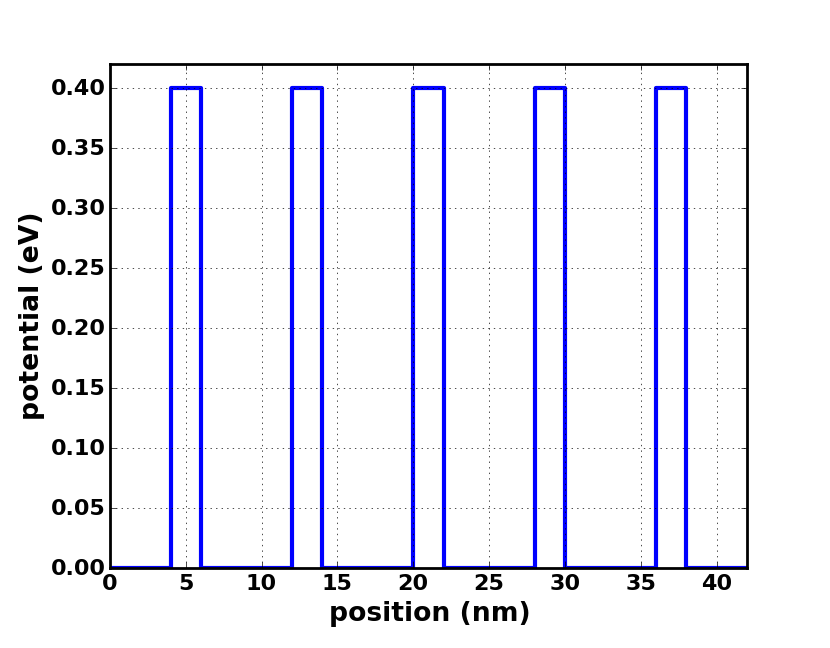Project Summary¶
Python codes provides a class object to simply calculate quantum mechanical transmission probability across arbitrary potential barriers by using the piece wise constant method. If you have a need to implement transmission probability into your code, it might be helpful.
There are several books and papers describing the piece wise constant method. I referred to specifically a paper by Ando and Itoh [1] along with a paper by Tsu and Esaki [2] and a book by Ferry and Goodnick [3].
Example¶
Tunneling through 5 barriers
|
Potential structure |
Biased at -0.2 (V) |
Result:
As can be seen, for 5 barriers without bias, the resonant energies are split into quadruplets. For n barriers, there should be n-1 fold splitting at resonant energies [2].
| [1] | Ando, Yuji, and Tomohiro Itoh. “Calculation of transmission tunneling current across arbitrary potential barriers.” Journal of applied physics 61.4 (1987): 1497-1502. |
| [2] | (1, 2) Tsu, R., and Leo Esaki. “Tunneling in a finite superlattice.” Applied Physics Letters 22.11 (1973): 562-564. |
| [3] | Ferry, David, and Stephen Marshall Goodnick. Transport in nanostructures. No. 6. Cambridge university press, 1997. |
Usage¶
Set up a desired structure in a separate python module just like below (my5barriers.py for example).
The main part is to set up:
- potential (eV)
- thickness (nm)
- effective_mass (m_0 electron free mass)
# list of effective masses from www.ioffe.ru/SVA/NSM/Semicond/index.html
m = {'GaAs': 0.063,
'AlxGa1-xAs': lambda x: 0.063+0.083*x,
'AlAs': 0.146,
'InN': 0.11,
'GaN': 0.20,
'InxGa1-xN': lambda x: 0.2+x*(0.11-0.2),
'InAs': 0.023}
# Set Up structure Here ---------------------------------------
# potential (eV)
# thickness (nm)
# effective_mass (m_0 electron free mass)
# Multiple Barriers
potential = [0.0, 0.4, 0.0, 0.4, 0.0, 0.4, 0.0, 0.4, 0.0, 0.4, 0.0]
thickness = [4, 2, 6, 2, 6, 2, 6, 2, 6, 2, 4]
effective_mass = [m['GaAs'], m['GaAs'], m['GaAs'], m['GaAs'],
m['GaAs'], m['GaAs'], m['GaAs'], m['GaAs'], m['GaAs'],
m['GaAs'], m['GaAs']]
Then, in the main module (myTransmissionCoefficient.py), import the module describing the structure ‘as myStr’, e.g.
>>> import my5barriers as myStr
Now create an object
>>> RTD = QuantumTransmissionCoefficientCalculator(20)
The number 20 indicates the subdivision which is useful when applying bias. Check the structure described in the module by
>>> RTD.plot_structure()
Currently, it shows only the potential structure, no effective mass.
Create an numpy array E describing the energy range of interest
>>> import numpy as np
>>> import nu
>>> E = np.linspace(0.01, .5, 1000)*nu.eV
where nu is a custom module dealing with units. In this case, nu.eV = 1.602176565e-19.
Now you can have a transmission coefficient in the desired energy range.
>>> TC = RTD.compute(E)
See Documentation for more details.


